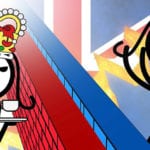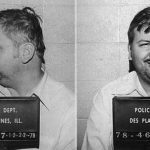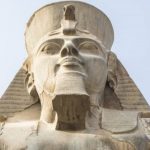 Mysteries
Mysteries  Mysteries
Mysteries  Technology
Technology 10 Times AI Replaced Humans (and No One Noticed)
 Politics
Politics 10 Dreaded Despots Who Met Untimely Deaths
 Pop Culture
Pop Culture 10 Celebs Who Have Surprisingly Wanted to Be on Reality TV
 Creepy
Creepy 10 of the Strangest Popular Creepypastas
 Animals
Animals 10 Animals That Used to Be Bigger
 Our World
Our World 10 American Cities, Towns & Villages That Are Unlike Any Other
 Movies and TV
Movies and TV 10 Huge Movies Almost Made by Other Directors
 Technology
Technology Lost in Transmission: 10 Unsung Heroes of Radio Innovation
 Miscellaneous
Miscellaneous 10 Incredibly Valuable Chinese Antiques Discovered by Accident
 Mysteries
Mysteries Ten Mysterious “Ghost Ship” Stories That Still Keep Us Wondering
 Technology
Technology 10 Times AI Replaced Humans (and No One Noticed)
 Politics
Politics 10 Dreaded Despots Who Met Untimely Deaths
Who's Behind Listverse?

Jamie Frater
Head Editor
Jamie founded Listverse due to an insatiable desire to share fascinating, obscure, and bizarre facts. He has been a guest speaker on numerous national radio and television stations and is a five time published author.
More About Us Pop Culture
Pop Culture 10 Celebs Who Have Surprisingly Wanted to Be on Reality TV
 Creepy
Creepy 10 of the Strangest Popular Creepypastas
 Animals
Animals 10 Animals That Used to Be Bigger
 Our World
Our World 10 American Cities, Towns & Villages That Are Unlike Any Other
 Movies and TV
Movies and TV 10 Huge Movies Almost Made by Other Directors
 Technology
Technology Lost in Transmission: 10 Unsung Heroes of Radio Innovation
 Miscellaneous
Miscellaneous 10 Incredibly Valuable Chinese Antiques Discovered by Accident
10 Facts that Make The Roanoke Colony Even More Mysterious
Welcome, history buffs and mystery lovers! Get ready to dive into the captivating story of the Roanoke Colony. We’re sharing ten mind-blowing facts that will make the mystery even more puzzling. From disappearing settlers to cryptic inscriptions and strange contracts, these details will keep you hooked.
Still unsolved today, this is a whirlwind of unanswered questions and fascinating theories. Let’s take a closer look into one mystery that has stood the test of time and discover why the Roanoke Colony continues to intrigue us to this day. Let’s go!
Related: 10 Peoples That Might Have Discovered America Before Columbus – 2020
10 No One Can Find Roanoke Now
There is very little physical evidence of the Roanoke Colony, and what little evidence there is has been lost or destroyed over time.
It is possible that the colonists relocated to another area, such as Croatoan Island, which is now known as Hatteras Island, or to a nearby Native American tribe.
The area where the colony was located was prone to natural disasters, such as hurricanes and flooding, which could have destroyed any remaining evidence of the colony.
There are conflicting accounts of what happened to the colonists, and historians and archaeologists have been unable to agree on a single theory.
Despite numerous attempts to locate the exact location of the Roanoke Colony, the mystery remains unsolved, and it is likely that the fate of the colonists will never be known for certain.
9 Carved Clues Left Behind
The Roanoke Colony, also known as the Lost Colony, was established on Roanoke Island off the coast of North Carolina in 1587. The colony disappeared without a trace by 1590, leaving behind only two clues. Here’s what historians think they mean:
The word “Croatoan” was carved into a post at the site of abandonment, which is now known as Hatteras Island. Croatoan is the name of a small tribe of Native Americans who lived in the Carolinas at the time. Historians believe that the colonists may have relocated to Croatoan Island or went to live among a nearby Native American tribe, possibly the Croatoan tribe.
The word “Cro” was etched into a tree near the abandoned fort. The meaning of this clue is less clear than that of “Croatoan.” Some historians believe that “Cro” may have been a shortened version of “Croatoan,” while others believe that it may have been a reference to a nearby body of water, such as the Croatan Sound.
8 The Man Behind the Plan
Walter Raleigh was an English statesman, soldier, writer, and explorer who lived during the Elizabethan era. Between 1584 and 1589, he helped establish a colony near Roanoke Island, which he named Virginia, but his life was full of wild adventures. Unfortunately, not all of them panned out the way he planned.
Raleigh played a leading part in the English colonization of North America, suppressed rebellion in Ireland, helped defend England against the Spanish Armada, and held political positions under Elizabeth I. He was knighted in 1585 and became Captain of the Queen’s Guard within two years. He also led two unsuccessful expeditions to South America in search of the fabled city of gold, El Dorado.
Things took a turn, though, when Raleigh was accused of treason by Elizabeth’s successor, James I, and was imprisoned in the Tower of London. He was eventually released to lead a second expedition to South America. But it was a failure, and he returned to England in disgrace. In 1618, he was accused of plotting against James I and was executed.
The state capital of North Carolina, its second-largest city, was named Raleigh in 1792 after Sir Walter, sponsor of the Roanoke Island colony.
7 Virginia was Named After the Queen
The colony of Virginia was named in honor of Queen Elizabeth I of England, who was called the “Virgin Queen” because she never married. And there are a few theories as to why she made such a modern decision.
First of all, Elizabeth I was a queen at a time when female monarchs were expected to marry and produce heirs to secure the succession of the throne. However, Elizabeth I believed that marriage would weaken her position as queen and make her subservient to her husband.
She may have also chosen not to marry for personal reasons. She was known to have had several close relationships with men, including Robert Dudley, but she never married any of them. Some historians speculate that she may have been afraid of losing her independence or that she may have been infertile.
Elizabeth I was also a Protestant queen in a time when England was divided between Protestants and Catholics. She may have believed that remaining unmarried would allow her to avoid the political and religious conflicts that would arise from marrying a Catholic prince.
Despite her status as the “Virgin Queen,” there is some doubt as to whether Elizabeth I was actually a lifelong virgin. However, her decision not to marry had a significant impact on English history and helped to establish her as one of England’s most famous monarchs.
6 Ralph Lane Murdered Chief Wingina
According to the sources, Ralph Lane, who was the governor of the Roanoke Colony in 1585, quarreled with Wingina, a Secotan weroance, who was attempting to organize neighboring tribes to attack Lane’s group. In an effort to gain more stocks of food for the fledgling colony, Lane led an attack on the Secotan on June 1, 1586, and Wingina was decapitated during the attack by one of Lane’s men. While some historians suggest that Lane killed Wingina, it is not clear whether Lane himself was responsible for Wingina’s death or whether it was one of his men who killed him.
Wingina’s death increased the hostility between the English and the Native Americans in the region. The Native Americans saw the English as a threat to their way of life, and the English saw the Native Americans as obstacles to their colonization efforts.
5 They Brought Croatoans Back to England
Before heading out himself, Sir Walter Raleigh sent Arthur Barlowe, an English explorer, with Philip Amadas to explore the eastern coast of North America in 1584. During their expedition, they landed on Roanoke Island and met with the Secotan and Croatan tribes. Barlowe brought back two Croatoans, Manteo and Wanchese, to England with him.
Manteo and Wanchese were presented to Queen Elizabeth I and were treated as ambassadors from the New World. Manteo was later baptized into the Church of England and was made Lord of Roanoke by Raleigh. The Croatoans played a significant role in the early English colonization efforts in North America and were instrumental in establishing peaceful relations between the English and the Native Americans in the region.
4 Two Failed Attempts to Colonize Roanoke
The Roanoke Colony was attempted twice by the English, once in 1585 and again in 1587. The first attempt to colonize Roanoke Island was led by Sir Richard Grenville in 1585. And Ralph Lane was appointed as the governor of the colony.
The second attempt to colonize Roanoke Island was led by John White in 1587. White was named governor of a new colony to be established north of Roanoke on the Chesapeake Bay. Overall, both attempts to colonize Roanoke Island were unsuccessful. The first colony returned to England, but the second colony, which was established in 1587, failed for unknown reasons, and around 115 men, women, and children vanished.
3 Governor White’s Strange Contract
Before leaving the Roanoke Colony in 1587, Governor White made a contract with the colonists. The contract was designed to establish the terms of the governor’s departure from the colony and ensure that the colonists would remain safe and secure in his absence.
The contract specified that the colonists would remain on Roanoke Island and that they would establish a permanent settlement there. The contract also specified that the colonists would be self-sufficient and work to establish friendly relations with the Native Americans in the region. But there was one other stipulation…
White was nervous about leaving his own belongings behind. The contract required the colonists to protect his things and promise not to steal from him. It’s essentially a pinky promise not to touch my stuff.
In return, Governor White promised to return to England to gather supplies and reinforcements for the colonists. He also promised to return to the colony as soon as possible. Unfortunately, his return to the colony was delayed by several years due to a variety of factors, including the Spanish Armada and a lack of funding. When he finally returned to Roanoke Island in 1590, he found the colony abandoned, and the fate of the colonists remains a mystery to this day.
Maybe they really did steal his stuff.
2 The First Baby Born in North America
Virginia Dare was the first English child born in the Americas, born on August 18, 1587, in Roanoke Colony. She was the daughter of Ananias Dare and Ellinor White Dare and the granddaughter of Governor John White. Virginia Dare was one of two infants born to the colonists in 1587 and the only female child known to have been born to the settlers. Her name was chosen to signify that she was the first English child born in Virginia.
Virginia Dare was baptized into the Church of England on August 24, 1587, and was the first child and second person in America christened into the Church of England.
1 You Can Visit the Memorial Bridge
The Virginia Dare Memorial Bridge is dedicated to the memory of Virginia Dare. When the colony disappeared without a trace, the fate of Virginia Dare and the other colonists remains a mystery to this day. The naming of the bridge after Virginia Dare is a way to honor her place in history and to remember the early English settlers who attempted to establish a colony in the New World.
The Virginia Dare Memorial Bridge is a four-lane automobile bridge that spans the Croatan Sound, between Manns Harbor and Roanoke Island, in Dare County, North Carolina. At a length of 5.2 miles (8.4 km), the Virginia Dare Memorial Bridge is the longest in the state. It hits 65 feet (20 m) high and is supported by 88 concrete columns. The bridge deck has 7,250 tons of steel and was built in 1995 with a 100-year life span.
Interested in making a visit? The bridge crosses from Manns Harbor to Roanoke Island, and you can find it at 100 S US Hwy 64, Manteo, NC.








